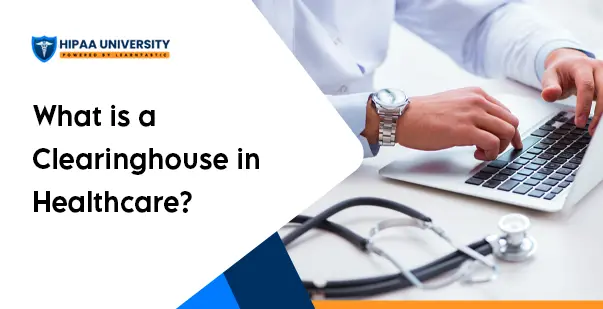What is a Clearinghouse in Healthcare?

August 8, 2024
Table of Contents:
- Introduction
- What is a Clearinghouse in Medical Billing?
- Issues in Processing Healthcare Claims
- Why Do You Need A Clearinghouse?
- HealthCare Clearinghouse as a HIPAA Compliant Entity
- Functions of a HealthCare Clearinghouse
- Medical Billing Process with Clearing Houses
- Choosing the Best Healthcare Clearinghouse
- Wrapping Up
The medical billing industry is complex, involving a complicated relationship between insurance companies and healthcare providers. HIPAA—the Health Insurance Portability and Accounting Act—addresses the importance of secure electronic data exchanges (EDI) and protecting patient privacy. HIPAA aims to safeguard health information.
Healthcare clearinghouses are essential for an efficient medical billing process. They act as an intermediary between the healthcare provider and the insurance company. Let’s examine the definition of a healthcare clearinghouse in detail and its role in medical billing.
What is a Clearinghouse in Medical Billing?
A healthcare clearinghouse is a third-party system. It converts claim data between insurance companies’ systems and provider systems. According to the Department of Health & Human Services, the healthcare clearinghouse definition is as follows – “it is a public or private entity, such as a billing assistance, repricing company, or community health records system, handling non-standard data or transactions that comes from one entity into regular transactions or data elements, or vice versa”.
Issues in Processing Healthcare Claims
Billing for hospital and provider supplies and services can be a difficult process in this complicated environment. Various diagnosis codes are available in the International Classification of Diseases Tenth Revision Clinical Modification (ICD-10-CM). It includes more than 68,000 codes to represent various diagnoses and treatments. Such medical coding services are frequently required to code healthcare claims accurately.
The number of healthcare providers in the nation exceeded thousands of insurance companies. Many payers and providers use software or systems to exchange protected health information (PHI), which may complicate matters. In addition, there are differences in state laws governing insurance and submitting claims.
- Issues in claim submissions may arise from human error and improper diagnosis codes. Wrong calculations, coverage denials, invalid EDI addresses, or payer information are other reasons.
- Issues can also arise due to a mismatch of the software and secure link establishment of healthcare organizations.
- In medical billing, claims correction and rejection management may also complicate operations. Also, it leads to prevent or delay payments.
Why Do You Need A Clearinghouse?
After understanding what is a clearinghouse in medical billing, let us look at its benefits. Adopting a medical billing clearinghouse service guarantees the timely processing of medical claims. To speed up the claims procedure, it serves as a third-party intermediary and guarantees data accuracy.
- Improved Efficiency: A medical clearinghouse can speed up the billing process by combining many claims into one batch. This saves time and effort compared to submitting each claim individually.
- Increased Accuracy: Medical clearinghouses lower the possibility of claims being rejected or delayed. They do this by using advanced software to verify claims and identify problems before they are submitted.
- Faster Payments: A medical clearinghouse can help providers get paid faster. It lets them submit insurance claims electronically instead of using paper billing. This is more efficient than traditional paper billing methods.
- Enhanced Security: Medical clearinghouses offer secure ways to send private patient data. This lowers the chance of security problems and keeps HIPAA rules.
- Access to Useful Data: Medical clearinghouses can help providers identify trends and make billing easier by offering helpful data reports and analytics.
- Cost Savings: A medical clearinghouse can result in financial savings for providers. It also lowers the chance of claim denials, minimizes the need for human data entry, and reduces errors.
- Improved Patient Satisfaction: It reduces the possibility of unfavorable reviews and complaints and increases patient satisfaction through Faster and more accurate billing.
HealthCare Clearinghouse as a HIPAA Compliant Entity
Compliant entities include healthcare providers, insurance companies, and healthcare clearinghouses. These entities are required to adhere to HIPAA regulations to safeguard the privacy and security of sensitive health information and provide payers and providers with certain rights regarding protected health information (PHI).
Thus, Companies that work with a covered entity, such as a healthcare clearinghouse, must comply with HIPAA regulations and guidelines. Similar to a service level agreement, this can be done in written form. It should specify the business associate’s liability in case they do not follow HIPAA requirements.
Read more: Complete HIPAA Compliance: IT Checklist, Security Rules & More
Functions of a HealthCare Clearinghouse
Below are the functions of a healthcare clearinghouse to streamline medical billing and credentialing process:
The clearinghouse verifies a patient’s insurance coverage before treatment. This stage helps providers establish clear billing expectations and lower claim denials by verifying that the insurance is active. It will also identify cover limits and highlight potential out-of-pocket costs.
Healthcare providers submit medical claims to the clearinghouse either directly or through management systems. This centralized filing helps ensure that the claim starts its journey in an organized manner and facilitates quick, standardized processing.
At this point, the claim is carefully examined by the clearinghouse. It looks for discrepancies, coding mistakes, and missing data. The goal of this “scrubbing” procedure is to identify and resolve issues, increasing the chances of claim approval.
According to HIPAA regulations, claims are generally converted into a format that is accepted worldwide. Regardless of the format of the original system, this standardization guarantees that insurance companies can easily read and process the claim.
Once the claim is standardized and error-free, it is electronically transmitted to the intended insurance payer. This smooth transition lowers the possibility of lost or delayed claims and is faster than manual submissions.
The healthcare provider receives an acknowledgement from the clearinghouse. Providers can feel secure in the filing procedure, knowing that the claim was successfully received and forwarded due to this acknowledgement.
After reviewing the claim, the insurance provider determines whether to approve it, deny it, or ask for additional information. Their choice is redirected through the clearinghouse, establishing a systematic communication channel.
The clearinghouse notifies the provider if the insurance company finds issues with the claim or rejects it outright. By identifying certain errors, providers can identify and fix the root causes, streamlining later submissions.
The clearinghouse assists in creating accurate patient bills after the insurance response is evident. These bills provide a clear analysis of any outstanding costs that are not covered by insurance. This will guarantee that any outstanding debts are disclosed.
Clearinghouses provide analytical tools in addition to processing claims. In-depth reports that show providers’ submission trends, success rates, and common refusal reasons are available for examination. These reports offer providers with important information for streamlining their operations.
Clearinghouses support claim denials by providing solutions and reasons for the denial. Medical practices can improve their chances of reimbursement and simplify their submission process. Additionally, they can take a proactive approach when handling persistent problems.
Medical Billing Process with Clearing Houses
Typically, the exchange proceeds as follows:
- Every claim that is entered into a medical billing software program is converted into an ANSI-X12-837 compliant file.
- This file gets uploaded to your medical clearinghouse account.
- Before forwarding it to a payer, the clearinghouse ensures that the uploaded file is error-free.
- Next, the file is delivered to the designated payer.
- The payer has the option to approve or deny the claim, depending on the circumstances.
- Any errors found by the insurance provider are reported to your clearinghouse. It then updates your dashboard with the information.
Every transmission takes place via a secure connection, as regulated by HIPAA (Health Insurance Portability and Accountability Act).
Read more: Who Must Comply with HIPAA Rules and Regulations?
Choosing the Best Healthcare Clearinghouse
Selecting the appropriate clearinghouse for your medical practice is essential to managing your cash flow. Finding a perfect match can be difficult with the many options available. Take into account the following best practices to help you make decisions:
When looking for potential suppliers, make sure their charges are within your budget. Get a cost breakdown and decide whether a web-based application or cloud-based Software-as-a-Service (SaaS) is more appropriate for your practice. Ask about additional costs and membership fees, such as those for Electronic Remittance Advice (ERA).
Medical billing software connected with your Electronic Health Record (EGR) is important. It serves as an integrated approach for your medical practice’s IT and billing requirements. Verify whether the clearinghouse of your choice offers software that integrates easily with the software you already have.
Select user-friendly software to reduce training time and streamline billing procedures. Make sure the appropriate staff members have simple access to the program. Also, consider whether the interface has features that simplify fundamental processes.
Reliable clearinghouses provide real-time support from qualified billers. Look for software with a chat feature that connects users with experienced billers if their application is rejected. These billers can assist in locating and fixing errors that come in rejections.
You and your team should be able to view and modify the status of submitted claims at any time with the clearinghouse’s web access. Make sure the clearinghouse is open 24/7.
Wrapping Up
Utilizing a healthcare clearinghouse can help a hospital or health system increase its effectiveness. It will also avoid the complexity and various issues of the healthcare sector. This streamlines electronic medical billing. To overcome software incompatibility, HIPAA-compliant healthcare providers can process multiple claims to multiple insurance providers.
Insurance billing clearinghouses provide several advantages, including faster payment and scrubbing out errors. In addition, it will lower administrative costs and provide a single source of contact for claim submissions and status updates. If the bills are submitted properly, then Medicare, Medicaid, or a commercial payer will pay more quickly. The quicker a patient receives an exact bill for any amount uncovered by insurance, the faster the funds can be gathered.





